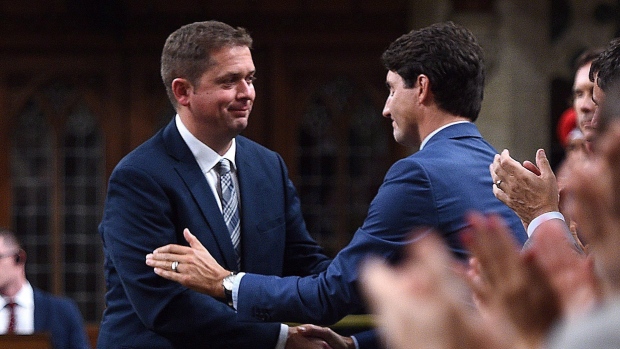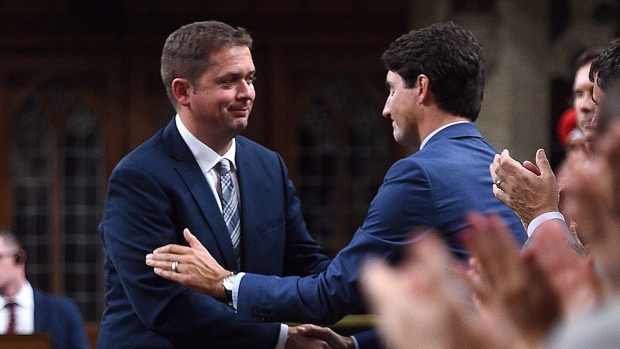
TORONTO — Political strategists tend to believe that conservatives usually win handily among older voters and get fewer votes from younger ones.
This election, then, may not exactly be considered the usual one.
The latest data from Nanos Research, which was commissioned by CTV News and The Globe and Mail, shows the Liberals and Conservatives running neck-and-neck among voters of nearly every generation.
“Almost every single age group, there is not anyone with a clear advantage,” pollster Nik Nanos said Monday on CTV’s Trend Line podcast.
“When I look through the demographic numbers, it’s like right across the board – young, middle-aged or old – you are unsure as to who you’d want to see (elected).”
The largest gap Nanos Research found between the two parties was in the 18-29 age group, where the Liberals were the preferred party of 32 per cent of voters, compared to 26 per cent support for the Conservatives.
The two parties were tied at 29 per cent support among voters in their 30s, with the Liberals eking out a small lead with voters in their 40s, at 36 per cent to 34 per cent for the Conservatives.
Voters in their 50s seem slightly more likely to prefer the Conservatives, whose support in that age group beats the Liberals 39 per cent to 35 per cent, but that edge didn’t continue with voters aged 60 and above, who had the parties in a tie at 37 per cent.
Younger voters were still more likely to opt for progressive parties overall, as Nanos Research found that support for the NDP and Green Party dropped significantly as voters aged.
These figures can be found in the Nanos Data Portal.
ONE IN EIGHT VOTERS UNDECIDED
Given the close race in almost every age group, it’s no surprise that the overall gap between the two parties is virtually negligible.
Nanos Research found that support for the Liberals has fallen to 34 per cent, down from the campaign high of 37 per cent recorded one day earlier, while the Conservatives held steady at 33 per cent for the third day in a row.
Support for the NDP remained at 15 per cent, while the Greens were back up to 10 per cent. The Bloc Quebecois was the preferred choice of 5 per cent of voters, and the People’s Party was polling at 2 per cent – both where they had been at the previous day.
Though every party has seen ebbs and flows in its support over the nearly four weeks since the campaign began, no party has seen a significant overall change in its support since Nanos’ daily tracking began on Sept. 13.
This suggests that nothing in the campaign thus far – not platform promises, not controversial candidates, not blackface photos, not the unexpected discoveries of a second Liberal plane and a second citizenship for Conservative Leader Andrew Scheer – appears to have done enough on its own to significantly alter the electorate’s mood.
“If the election were a desert, right now Canadians would drink a dirty glass of water because it has just been so absent of the things that they want to talk and hear about,” Nanos said.
While the number of undecided voters has fallen slightly from the beginning of the campaign, approximately one in eight voters say they still don’t know how they will cast their vote.
That could change this week, particularly if a large number of those undecided voters tune in to Monday’s English-language leaders’ debate and Thursday’s French-language follow-up.
As Nanos sees it, the advantage there could go to whichever party ignores “zinger lines” and attacks on opponents in favour of calmly laying out their plans for Canada.
“I think that everyone would be well served if all of the federal party leaders could at least start skirmishing and setting forth their different views and visions for the country based on the environment and the economy, because that’s what people want to hear about,” he said.
METHODOLOGY
The Nightly Nanos Election Tracking is produced by Nanos Research, CTV News and the Globe and Mail. The data is based on dual frame (land + cell-lines) random telephone interviews using live agents of 1,200 Canadians using a three night rolling average of 400 respondents each evening, 18 years of age and over.
The random sample of 1,200 respondents may be weighted by age and gender using the latest census information for Canada. The interviews are compiled into a three night rolling average of 1,200 interviews, where each evening the oldest group of 400 interviews is dropped and a new group of 400 interviews is added.
A random telephone survey of 1,200 Canadians is accurate ±2.8 percentage points, plus or minus, 19 times out of 20.








